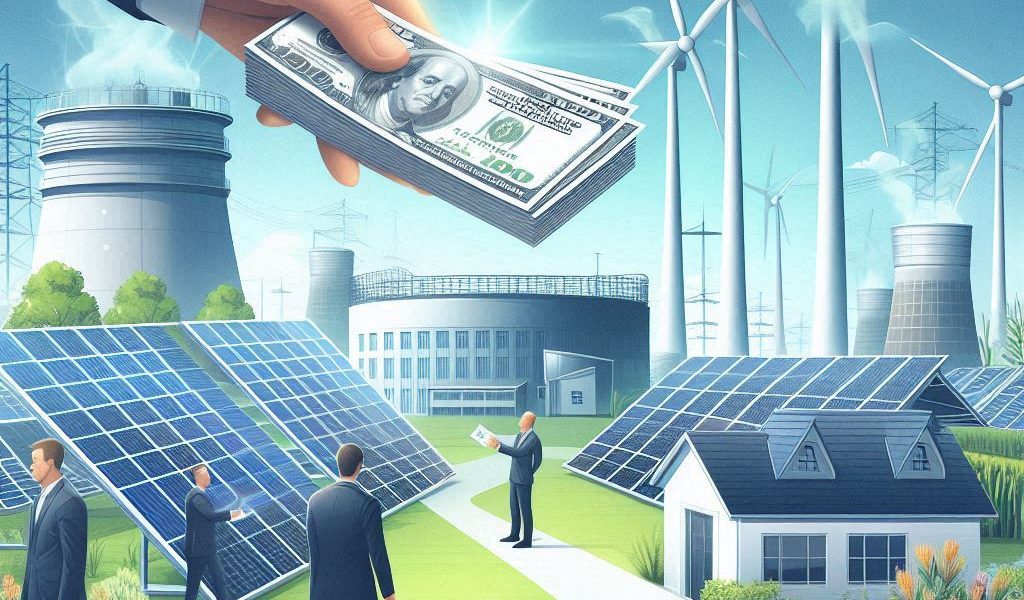With the growing need for sustainable energy solutions, governments worldwide are offering various subsidies and incentives to promote renewable energy projects. These financial aids aim to accelerate the adoption of solar, wind, and bioenergy technologies, reducing reliance on fossil fuels and contributing to a greener planet. If you are an investor, entrepreneur, or homeowner interested in renewable energy, understanding these subsidies can help you make informed decisions.
This article provides a comprehensive guide to renewable energy subsidies, focusing on incentives for solar, wind, and bioenergy projects, eligibility criteria, and the application process.
Why Governments Offer Renewable Energy Subsidies
Governments provide renewable energy subsidies to:
- Encourage sustainable development: Reduce carbon emissions and promote clean energy.
- Support green businesses: Help renewable energy companies compete with traditional fossil fuels.
- Make renewable energy affordable: Lower costs for individuals and businesses adopting clean energy.
- Achieve energy security: Reduce dependence on imported fossil fuels.
- Create jobs: Boost employment opportunities in the green energy sector.
Types of Renewable Energy Subsidies & Incentives
1. Investment Grants for Renewable Energy Projects
Governments offer direct financial assistance to businesses and individuals investing in solar, wind, and bioenergy projects. These grants can cover:
- Solar panel installations
- Wind turbine setup
- Bioenergy production facilities
2. Tax Credits & Rebates
Many countries provide tax benefits for renewable energy investments, including:
- Investment Tax Credits (ITC): A percentage of installation costs deducted from taxes.
- Production Tax Credits (PTC): Tax reductions based on energy generated.
- Accelerated Depreciation: Businesses can claim deductions for renewable energy assets faster.
3. Feed-in Tariffs (FiTs) & Net Metering
- Feed-in Tariffs (FiTs): Governments pay renewable energy producers for feeding excess power into the grid.
- Net Metering: Allows homeowners and businesses to offset electricity bills by exporting surplus energy to the grid.
4. Low-Interest Loans & Green Financing
Governments and financial institutions offer subsidized loans with lower interest rates for renewable energy projects, making it easier for businesses and individuals to invest in clean energy.
5. Research & Development (R&D) Grants
Funding is available for companies, universities, and research institutions working on innovative renewable energy solutions.
6. Subsidized Equipment & Infrastructure Development
- Reduced import duties on solar panels, wind turbines, and bioenergy equipment.
- Grants for building infrastructure like smart grids and battery storage systems.
Government Incentives for Solar Energy Projects
Solar energy is one of the most widely subsidized renewable energy sources. Common incentives include:
- Solar Investment Grants: Financial support for rooftop solar installations and large-scale solar farms.
- Residential Solar Tax Credits: Homeowners receive tax benefits for installing solar panels.
- Solar Panel Leasing & Power Purchase Agreements (PPAs): Programs that allow businesses and individuals to install solar panels with little or no upfront cost.
- Solar Water Heating Subsidies: Discounts on solar water heater installations.
Government Incentives for Wind Energy Projects
Wind energy is crucial for clean power generation, and subsidies include:
- Wind Farm Development Grants: Support for setting up onshore and offshore wind farms.
- Wind Power Tax Incentives: Tax credits for businesses investing in wind energy.
- Grid Connectivity Support: Assistance for integrating wind power into the national electricity grid.
- Land Lease Subsidies: Discounts on government-owned land for wind farm projects.
Government Incentives for Bioenergy Projects
Bioenergy, derived from organic materials, receives various subsidies, including:
- Biogas & Biomass Subsidies: Financial aid for setting up biogas plants and biomass energy production units.
- Ethanol & Biodiesel Production Grants: Support for companies producing biofuels.
- Waste-to-Energy Incentives: Grants for projects converting waste into energy.
- Agricultural Residue Utilization Subsidies: Funding for farmers to use crop waste for bioenergy production.
Eligibility Criteria for Renewable Energy Subsidies
Each subsidy program has specific eligibility requirements, but general criteria include:
- Project Type: Residential, commercial, or industrial renewable energy installations.
- Ownership Status: Homeowners, businesses, or energy developers.
- Location: Some subsidies are region-specific.
- Technology Compliance: Meeting technical standards for renewable energy equipment.
- Grid Connection Requirements: For projects involving energy distribution.
How to Apply for Renewable Energy Subsidies
Step 1: Research Available Programs
- Visit official government energy department websites.
- Contact local renewable energy agencies.
- Consult financial institutions offering green energy financing.
Step 2: Check Eligibility
- Read program guidelines carefully.
- Ensure compliance with all technical and legal requirements.
Step 3: Gather Required Documents
Common documents include:
- Project proposal & feasibility study
- Business or personal identification documents
- Proof of land ownership or lease agreements
- Technical specifications of renewable energy equipment
Step 4: Submit Application
- Most subsidy programs allow online applications.
- Some require physical submission through energy departments or financial institutions.
Step 5: Follow Up & Approval Process
- Monitor the status of your application online.
- Provide additional documents if requested.
- Once approved, subsidies are either disbursed as direct financial aid, tax credits, or rebates.
Common Mistakes to Avoid When Applying for Renewable Energy Subsidies
- Incomplete Documentation: Submit all required paperwork to prevent delays.
- Ignoring Deadlines: Apply within the designated timeframe.
- Incorrect Project Specifications: Ensure compliance with program requirements.
- Not Researching Multiple Programs: Explore all available subsidies for maximum benefits.
- Failing to Follow Up: Stay informed about your application status.
Benefits of Renewable Energy Subsidies
- Lower Installation Costs: Reduces upfront expenses for renewable energy systems.
- Faster Return on Investment (ROI): Shortens the payback period for solar, wind, and bioenergy projects.
- Encourages Sustainability: Supports clean energy adoption and reduces carbon footprints.
- Boosts Economic Growth: Creates jobs in the renewable energy sector.
- Reduces Dependence on Fossil Fuels: Enhances energy security and independence.
Conclusion
Renewable energy subsidies provide crucial financial support for individuals and businesses transitioning to clean energy. Whether you’re interested in solar, wind, or bioenergy projects, these incentives can significantly reduce costs and encourage sustainable energy adoption.
To take advantage of these programs, research available subsidies, check eligibility, and submit a well-prepared application. With the right financial support, investing in renewable energy can be both economically and environmentally rewarding.




